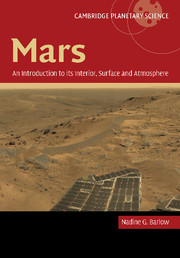Book contents
- Frontmatter
- Contents
- Preface
- 1 Introduction to Mars
- 2 Formation of Mars and early planetary evolution
- 3 Geophysical measurements and inferred interior structure
- 4 Surface characteristics
- 5 Geology
- 6 Atmospheric conditions and evolution
- 7 History of water on Mars
- 8 Search for life
- 9 Looking ahead
- References
- Appendix: Mission reports
- Index
- Plate section
3 - Geophysical measurements and inferred interior structure
Published online by Cambridge University Press: 15 December 2009
- Frontmatter
- Contents
- Preface
- 1 Introduction to Mars
- 2 Formation of Mars and early planetary evolution
- 3 Geophysical measurements and inferred interior structure
- 4 Surface characteristics
- 5 Geology
- 6 Atmospheric conditions and evolution
- 7 History of water on Mars
- 8 Search for life
- 9 Looking ahead
- References
- Appendix: Mission reports
- Index
- Plate section
Summary
Geophysical measurements allow scientists to remotely determine the interior structure of a planet (Hubbard, 1984). Gravity deviations from those expected for a homogeneous spherical body provide information about a planet's shape, core, topography, and distribution of subsurface mass. Heat flow measurements provide insights into the thermal history of the planet and the current distributions of radioisotopes. Seismic data reveal the detailed internal structure of the planet and magnetic field data provide information on the core. Thus, geophysical studies provide important constraints on regions of the planet inaccessible to in situ study.
Shape and geodetic data
Shape of Mars
The shape of Mars is derived from detailed MOLA topography combined with gravity measurements from MGS Doppler tracking data (Lemoine et al., 2001; Smith et al., 2001a). The shape is defined relative to the planet's center of mass (COM). Mars' equatorial radius is 3396.200 km as measured from the COM. COM is offset slightly to the north (primarily because of the Tharsis Bulge), resulting in a north polar radius of 3376.189 km, compared to the south polar radius of 3382.580 km. Because of its rotation, Mars is slightly flattened (Section 1.4.2), with a value of 0.00648.
The shape of Mars is best approximated as a triaxial ellipsoid (Smith et al., 2001a). We can define a Cartesian coordinate system centered at the COM, with the z-axis corresponding to the rotation axis and the x- and y-axes passing through the equatorial region (Figure 3.1).
- Type
- Chapter
- Information
- Publisher: Cambridge University PressPrint publication year: 2008



